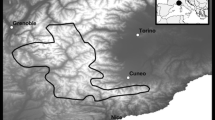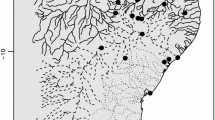Abstract
Species distribution models (SDMs) yield reliable and needed predictions to identify regions that have similar environmental conditions and were used here to predict potential ranges of rare species to identify new localities were they might occur based on their occurrence probability (i.e. niche suitability). We modeled the potential distribution ranges of ten endangered or rare birds from the South American Cerrado biome, using four temperature- and four precipitation-related bioclimatic variables, three topographical variables, and nine different niche modeling methods for each species. We used an ensemble-forecasting approach to reach a consensus scenario to obtain the average distribution for each species based on the five best models generating a distribution map of each species. Model efficiency was related to sample size and not appropriate below ten independent spatial occurrences. The potential distributions of seven species revealed that their occurrence ranges might go beyond their known ranges, but that most of them seem to occur near the regions where they have already been reported. The models of only three species were considered unsatisfactory in helping identify their potential distribution. Models created maps with higher occurrence probability regions where rare Cerrado birds might occur. These range projections can potentially decrease the costs and improve the efficiency of future field searches. On methodological terms, the application of SDMs to predict species ranges should compare different modeling methods and evaluate the effect of sample size on their performance.


Similar content being viewed by others
References
Araújo MB, New M (2007) Ensemble forecasting of species distributions. Trends Ecol Evol 22:42–47
Araújo MB, Pearson RG, Thuiller W, Erhard M (2005a) Validation of species-climate impact models under climate change. Global Change Biol 11:1504–1513
Araújo MB, Whittaker RJ, Ladle RJ, Erhard M (2005b) Reducing uncertainty in projections of extinction risk from climate change. Global Ecol Biogeogr 14:529–538
Barry S, Elith J (2006) Error and uncertainty in habitat models. J Appl Ecol 43:413–423
Brannstrom C, Jepson W, Filippi AM, Redo D, Xu Z, Ganesh S (2008) Land change in the Brazilian savanna (Cerrado), 1986–2002: comparative analysis and implications for land-use policy. Land Use Policy 25:579–595
BRASIL (2007) Mapas de cobertura vegetal dos biomas brasileiros. [Online] Available at http://www.mma.gov.br
Broennimann O, Guisan A (2008) Predicting current and future biological invasions: both native and invaded ranges matter. Biol Lett 4:585–589
CBRO (2008) Checklist of the birds of Brazil. Version 05/10/2008. CBRO (Comitê Brasileiro de Registros Ornitológicos) [Online] Available at http://www.cbro.org.br
Dias BFS (1990) Conservação da natureza no cerrado brasileiro. In: Pinto MN (ed) Cerrado: caracterização, ocupação e perspectivas. Editora Universidade de Brasília, Brasília, pp 583–640
Elith J, Graham CH, Anderson RP, Dudík M, Ferrier S, Guisan A, Hijmans RJ, Huettmann F, Leathwick JR, Lehmann A, Li J, Lohmann LG, Loiselle BA, Manion G, Moritz C, Nakamura M, Nakazawa Y, Overton JMcC, Peterson AT, Phillips SJ, Richardson KS, Scachetti-Pereira R, Schapire RE, Soberón J, Williams S, Wisz MS, Zimmermann NE (2006) Novel methods improve prediction of species’ distributions from occurrence data. Ecography 29:129–151
Fielding AH, Bell JF (1997) A review of methods for the assessment of prediction errors in conservation presence/absence models. Environ Conserv 24:38–49
Franklin J, Wejnert KE, Hathaway SA, Rochester CJ, Fisher RN (2009) Effect of species rarity on the accuracy of species distribution models for reptiles and amphibians in southern California. Div Distrib 15:167–177
Guisan A, Broennimann O, Engler R, Vust M, Yoccoz NG, Lehmann A, Zimmermann NE (2006) Using niche-based models to improve the sampling of rare species. Conserv Biol 20:501–511
Hannah L, Midgley GF, Millar D (2002) Climate change-integrated conservation strategies. Global Ecol Biogeogr 11:485–495
Heikkinen RK, Luoto M, Araújo MB, Virkkala R, Thuiller W, Sykes MT (2006) Methods and uncertainties in bioclimatic envelope modelling under climate change. Progr Phys Geogr 30:751–777
Hernandez PA, Graham CH, Master LL, Albert DL (2006) The effect of sample size and species characteristics on performance of different species distribution modeling methods. Ecography 29:773–785
Hijmans RJ, Cameron SE, Parra JL, Jones P, Jarvis A (2005) Very high resolution interpolated climate surfaces for global land areas. Int J Climatol 25:1965–1978
Hurlbert AH, White EP (2005) Disparity between range map- and survey-based analyses of species richness: patterns, processes and implications. Ecol Lett 8:319–327
IBAMA (2003) Lista das espécies da fauna ameaçada de extinção. Instrução Normativa n° 3, de 27 de maio de 2003. Instituto Brasileiro do Meio Ambiente e dos Recursos Naturais Renováveis (IBAMA)/Ministério do Meio Ambiente, Brasília
IUCN (2008) IUCN red list of threatened species. [Online] Available at http://www.iucnredlist.org
Kirwan GM, Barnett JM, Minns J (2001) Significant ornithological observations from the Rio São Francisco Valley, Minas Gerais, Brazil, with notes on conservation and biogeography. Ararajuba 9:145–161
Klink CA, Machado RB (2005) Conservation of the Brazilian Cerrado. Conserv Biol 19:707–713
Liu C, Berry PM, Dawson TP, Pearson GP (2005) Selecting thresholds of occurrence in the prediction of species distributions. Ecography 28:385–393
Lobo JM, Jiménez-Valverde A, Real J (2008) AUC: misleading measure of the performance of predictive distribution models. Global Ecol Biogeogr 17:145–151
Loiselle BA, Howell CA, Graham CH, Goerck JM, Brooks T, Smith KG, Williams PH (2003) Avoiding pitfalls of using species distribution models in conservation planning. Conserv Biol 17:1591–1600
Lopes LE (2008) The range of the curl-crested jay: lessons for evaluating bird endemism in the South American Cerrado. Div Distrib 14:561–568
Lopes LE, Maldonado-Coelho M, Hoffmann D, Luiz ER, D’Angelo Neto S (2008) Geographic distribution, habitat association, and conservation status of the critically endangered Minas Gerais tyrannulet Phylloscartes roquettei. Bird Conserv Int 18:53–62
Luoto M, Pöyry J, Heikkinen RK, Saarinen K (2005) Uncertainty of bioclimate envelope models based on the geographical distribution of species. Global Ecol Biogeogr 14:575–584
Machado RB, Ramos Neto MB, Pereira PGP, Caldas EF, Gonçalves DA, Santos NS, Tabor K, Steininger M (2004) Estimativas de perda da área do Cerrado brasileiro. Conservação Internacional do Brasil, Brasília
Manel S, Williams HC, Ormerod SJ (2001) Evaluating presence-absence models in ecology: the need to account for prevalence. J Appl Ecol 38:921–931
Marini MÂ, Garcia FI (2005) Bird conservation in Brazil. Conserv Biol 19:665–671
Marini MÂ, Barbet-Massin M, Lopes LE, Jiguet F (2009a) Predicted climate-driven bird distribution changes and forecasted conservation conflicts in a neotropical savanna. Conserv Biol 23:1558–1567
Marini MÂ, Barbet-Massin M, Lopes LE, Jiguet F (2009b) Major current and future gaps of Brazilian reserves to protect Neotropical savanna birds. Biol Conserv 142:3039–3050
Marmion M, Parviainen M, Luoto M, Heikkinen RK, Thuiller W (2009) Evaluation of consensus methods in predictive species distribution modelling. Div Distrib 15:56–69
Mata H, Fontana CS, Maurício GN, Bornschein MR, Vasconcelos MF, Bonatto SL (2009) Molecular phylogeny and biogeography of the eastern Tapaculos (Aves: Rhinocryptidae: Scytalopus, Eleoscytalopus): cryptic diversification in Brazilian Atlantic Forest. Mol Phyl Evol 53:450–462
Mattos GT, Andrade MA, Freitas MV (1991) Levantamento de aves silvestres na região noroeste de Minas Gerais. Rev Soc Ornitol Mineira 39:26–29
McKelvey KS, Aubry KB, Schwartz MK (2008) Using anecdotal occurrence data for rare or elusive species: the illusion of reality and a call for evidentiary standards. Bioscience 58:549–555
McPherson JM, Jetz W (2007) Effects of species’ ecology on the accuracy of distribution models. Ecography 30:135–151
Miles L, Newton AD, De Fries RS, Ravilious C, May I, Blyth S, Kapos V, Gordon JE (2006) A global overview of the conservation status of tropical dry forests. J Biogeogr 33:491–505
Mittermeier RA, Myers N, Gil PR, Mittermeier CG (1999) Hotspots: earth’s biologically richest and most endangered terrestrial ecoregions. CEMEX, Mexico City
Moisen GG, Frescino TS (2002) Comparing five modelling techniques for predicting forest characteristics. Ecol Mod 157:209–225
Muñoz J, Felicísimo ÁM (2004) Comparison of statistical methods commonly used in predictive modelling. J Veg Sc 15:285–292
Myers P, Hansen RL (1980) Rediscovery of the rufous-faced crake (Laterallus xenopterus). Auk 97:901–902
Myers N, Mittermeier RA, Mittermeier CG, Fonseca GAB, Kent J (2000) Biodiversity hotspots for conservation priorities. Nature 403:853–858
Paynter RA Jr, Traylor MA Jr (1991) Ornithological gazetteer of Brazil, 2 vols. Museum of Comparative Zoology, Cambridge
Pearson RG, Thuiller W, Araújo MB, Martínez-Meyer E, Brotons L, McClean C, Miles L, Segurado P, Dawson TP, Lees DC (2006) Model-based uncertainty in species range prediction. J Biogeogr 33:1704–1711
Pearson RG, Raxworthy CJ, Nakamura M, Peterson AT (2007) Predicting species distributions from small numbers of occurrence records: a test case using cryptic geckos in Madagascar. J Biogeogr 34:102–117
Peterson AT, Soberón J, Sánchez-Cordero V (1999) Conservatism of ecological niches in evolutionary time. Science 285:1265–1267
Phillips SJ, Anderson RP, Schapire RE (2006) Maximum entropy modeling of species geographic distributions. Ecol Mod 190:231–259
PROBIO-MMA (2007) Mapeamento de cobertura vegetal do Bioma Cerrado—Edital Probio 02/2004 (2/2004 (Executivo B.02.02.109)—Relatório Final. Brasília, DF, Junho/2007. [Online]. Available at http://www.mma.gov.br/inidex.php?ido=conteudo.monta&idEstrutura=72&idMenu=3813&idConteudo=5978
Pulliam HR (2000) On the relationship between niche and distribution. Ecol Let 3:349–361
Raposo MA, Kirwan GM (2008) The species complex Scytalopus speluncae: how many times a holotype can be overlooked? Rev Bras Ornitol Ararajuba 16:78–81
Ratter JA, Ribeiro JF, Bridgewater S (1997) The Brazilian Cerrado vegetation and threats to its biodiversity. Ann Bot 80:223–230
Richardson DM, Thuiller W (2007) Home away from home-objective mapping of high-risk source areas for plant introductions. Div Distrib 13:299–312
Schadt S, Revilla E, Wiegand T, Knauer F, Kaczensky P, Breitenmoser U, Bufka L, Cerveny J, Koubek P, Huber T, Stanisa C, Trepl L (2002) Assessing the suitability of central European landscapes for the reintroduction of Eurasian lynx. J Appl Ecol 39:189–203
Segurado P, Araújo MB (2004) An evaluation of methods for modelling species distributions. J Biogeogr 31:1555–1568
Silva JMC (1995) Avian inventory of the cerrado region, South America: implications for biological conservation. Bird Conserv Int 5:15–28
Silva JMC (1997) Endemic bird species and conservation in the Cerrado Region, South America. Biodiver Conserv 6:435–450
Silva JMC, Bates JM (2002) Biogeographic patterns and conservation in the South American Cerrado: a tropical savanna hotspot. Bioscience 52:225–234
Soberón J, Peterson AT (2005) Interpretation of models of fundamental ecological niches and species’ distributional areas. Biodiv Inf 2:1–10
Thompson WL (ed) (2004) Sampling rare or elusive species: concepts, designs, and techniques for estimating population parameters. Island Press, Washington, DC
Thuiller W (2003) BIOMOD—Optimizing predictions of species distributions and projecting potential future shifts under global change. Global Change Biol 9:1353–1362
Thuiller W (2004) Patterns and uncertainties of species’ range shifts under climate change. Global Change Biol 10:2020–2027
Thuiller W, Araújo MB, Lavorel S (2003) Generalized models vs. classification tree analysis: predicting spatial distributions of plant species at different scales. J Veg Sc 14:669–680
Thuiller W, Araújo MB, Pearson RG, Whittaker RJ, Brotons L, Lavorel S (2004) Biodiversity conservation: uncertainty in predictions of extinction risk. Nature 430:33
Vanzolini PE (1992) A supplement to the ornithological gazetteer of Brazil. Museu de Zoologia, Universidade de São Paulo, São Paulo
Vasconcelos MF, D’Angelo Neto S, Kirwan GM, Bornschein MR, Diniz MG, Silva JF (2006) Important ornithological records from Minas Gerais state, Brazil. Bull Br Ornithol Club 126:212–238
Wilson KA, Westphal MI, Possingham HP, Elith J (2005) Sensitivity of conservation planning to different approaches to using predicted species distribution data. Biol Conserv 122:99–112
Acknowledgments
M.Â.M. was supported by a Post-doctorate fellowship from CAPES, and L.E.L. by a doctorate fellowship from FAPEMIG. We thank W. Thuiller for providing the updated version of BIOMOD and A. T. Peterson for providing the topographical layers.
Author information
Authors and Affiliations
Corresponding author
Additional information
Communicated by J. Fjeldså.
Appendix
Appendix
See Fig. 3
Occurrence probabilities (niche suitability) of three species: Rufous-faced Crake Laterallus xenopterus (a), Blue-eyed Ground-dove Columbina cyanops (b), and White-winged Nightjar Eleothreptus candicans (c), with low AUC values or widespread occurrence regions. Occurrence probabilities are: above the threshold (black) or below the threshold (light grey)
Rights and permissions
About this article
Cite this article
Marini, M.Â., Barbet-Massin, M., Lopes, L.E. et al. Predicting the occurrence of rare Brazilian birds with species distribution models. J Ornithol 151, 857–866 (2010). https://doi.org/10.1007/s10336-010-0523-y
Received:
Revised:
Accepted:
Published:
Issue Date:
DOI: https://doi.org/10.1007/s10336-010-0523-y





